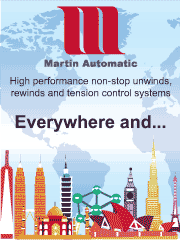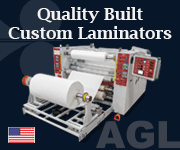Featured Stories
-
Three Common Types of Coating and Laminating Defects and the Methods of Inspection to Catch Them
You're close to securing a new contract and the client wants to know more about your quality control processes. -
-
Speaking the Language of Sustainability for Printers and Converters
Those of us who have spent time in the printing and packaging industry know it's a sector marked by incredible innovation, ingenuity and...
News | New Products
-
Anderson & Vreeland, Inc. Hires Kelly Conner as a Business Development Manager for Liquid, Thermal, Solvent & Water-Wash Photopolymers
Anderson & Vreeland, a privately held company with over 60 years of experience as a leading supplier of printing...
-
New Milestones for Vapor Pipe Shield Propel Momentum Toward New Industry Standard
Spring 2025 has seen exciting developments for the Vapor Pipe Shield, a patented technology from General Air Products (GAP)
-
Veritiv Continues to Invest in Print Solutions to Offer Customers Best-in-Class Products and Services
Veritiv Operating Company, America's premier print solutions provider, announced its leading coated paper brand, Endurance
-
MicroDynamics and BW Converting Partner to Advance Anilox QC Automation
MicroDynamics, innovative manufacturer of surface profile inspection systems, and BW Converting, leading provider of printing
-
INX International launches Innova Plus NCF: Nitrocellulose-Free inks for Sustainable Packaging
INX International has added a valuable new universal lamination system to its sustainable inks portfolio.
-
Quality Control Solutions for Silicone Release Coaters
Do your quality control tools give you the confidence to make fast, informed decisions — whether in-line or at-line?
-
Leadership in Converting through Static Control Solutions
TAKK Industries is an early innovator in the static elimination field, originating best in class static control solutions since 1943.
Expert Advice
Wide vs Narrow Web FlexoIt's More Than Just the Width
- Published: March 01, 2001, By Richard M. Podhajny, Ph.D., Contributing Editor
Flexography is the fastest growing printing process. This growth has come from many flexographic printing sectors, including wide web flexible packaging and narrow web label printing.
Wide web flexography has evolved into the highly efficient process we recognize today. Narrow web flexographic printing has evolved to a high quality printing process, but with a difference: It has been fueled by the use of radiation-curable inks.
Unrestricted use of solvent-based inks and coatings in wide web flexo was challenged by the EPA rules on solvent emissions. The flexographic industry responded with compliance strategies that included solvent incineration, solvent recovery, water-based technology, and radiation-curable systems. Wide web and narrow web flexography have been able to utilize water-based technology, and today, use of water-based flexographic inks is commonplace.
UV-curable flexographic inks have proved to be well-suited particularly to narrow web printing. This technology not only provides environmental compliance to solvent emissions but also provides improved quality printing and increased productivity.
The primary difference between wide web and narrow web flexo printing lies not only in the difference of printing width but in the speed of the printing process. Whereas a wide web printing application can run at speeds above 1,000 fpm, narrow web flexographic printing speeds are often in the range of a few hundred feet per minute. This difference in press speed has a major impact on the ink formulation composition. Wide web inks utilize faster drying solvents, and most jobs require very low solvent retention levels. This is particularly the case with laminating inks.
Narrow web flexo water-based inks use slower drying components. Typically, glycols and slower drying amines are used with fine line anilox rolls.
However, the use of slower solvents in narrow web inks increases the potential for solvent retention and product odor. The ink formulator must carefully balance the ink's drying rate to keep the ink “open” on the anilox rolls and printing plates, yet not leave retained solvent in the “dried ink film.”
Whereas wide web flexographic ink viscosities are about 25 sec, #2 Zahn, viscosities in narrow web typically are higher at about 35 sec, #3 Zahn. So, all things being equal, the narrow web will transfer a thicker ink film.
Flexographic UV-curable inks are well suited for very fine anilox rolls, since they stay open and dry rapidly by UV light, maintaining the very fine dot structure.
While wide web printing is dominated by a central impression (CI) drum flexographic configuration to maintain good register, most narrow web presses have an in-line configuration. The CI drum is at a constant temperature of about 98 deg F, and in-between dryers are used as well as a post-dryer. Narrow web presses commonly utilize only in-between dryers without post drying.
Wide web presses typically use the chambered doctor blade ink metering system, but narrow web presses use an ink fountain and a trailing doctor blade mounted on the anilox roll. As a result, the narrow web press can be more vulnerable to solvent loss and pH variation in the ink fountain due to evaporation.
Flexography experienced a major growth spurt with the rise of narrow web due to market demand for higher quality and greater productivity. This growth came from the use of UV inks that allowed for higher speeds and quality, and it took away business from gravure as well as lithography.
Flexography has proved itself a versatile process that can meet the economic and quality demands of our markets, and therefore it will continue to grow. As for wide web versus narrow web flexo printing, the two will continue to converge now that “mid-web flexo” is emerging as a hybrid compromise between both printing sectors.
Dr. Richard M. Podhajny has been in the packaging and printing industry for more than 30 years. Contact him at 215/616-6314, e-mail: rpodhajny@colorcon.com.























